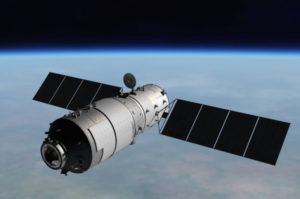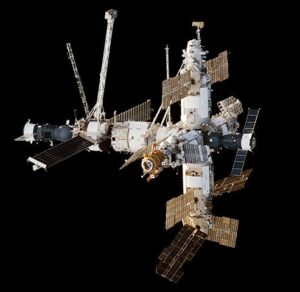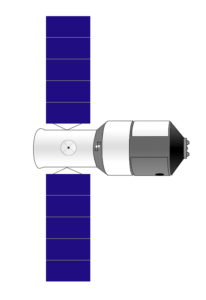Forgive me for the title – I needed something that wasn’t the same “Tiangong-1 Will Crash Into Earth” article title that every other place covering this seems to be using.
The statement is true, though. For whatever reason, contact and control of Tiangong-1 was lost in early 2016, and over the past year and a half atmospheric drag has begun to bring the space station down, in the same way as Skylab in the 1970’s, as well as many other satellites, and a few of the Soviet era Salyut / Almaz stations.
Tiangong-1 was launched in 2011 and was visited by the unmanned Shenzhou 8 vehicle for China’s first space docking, as well as the crewed Shenzhou 9 and 10 missions. Following these flights, the station was put into a standby mode in 2013. As mentioned above in early 2016, CNSA announced that the station’s mission was over – later amateur observations revealed that the CNSA had lost control of the station.

CG rendering of a Tiangong space station.
Most content you will read on this subject will use the rather shocking phrase “crash to earth” and while this isn’t wrong, it isn’t accurate fully. As with any object coming down from orbit, friction with the atmosphere will heat up the space station, destroying most of it. There are, however, heavier sections, such as the docking system, which are dense enough to likely survive the heat of re-entry and hit the surface.
That’s where the problem is. It isn’t so much an issue of a whole space station falling somewhere, but large sections that could still do damage. Under normal circumstances, if China still had control of the station, they could use engines on the vehicle itself, or engines on a vehicle docked with the station to de-orbit it over an appropriate area, allowing the debris to fall safely into the ocean. Such a technique was done with the MIR space station in 2001.

The Russian Space Station Mir
Of course, that’s not too easy to do when you lose contact with your space station and can no longer control it, or when you don’t have a vehicle ready to do such – even then, the aforementioned loss of contact would make such with an automated vehicle nearly impossible. A manned mission could, in theory, repair the station, but that alone would be incredibly risky and might not even be feasible, and would still require a second automated vehicle to launch to actually de-orbit the station, as using the crew vehicle to do such would mean the crew re-entering dangerously close to the station – a terrible idea on all fronts.
Now, I’m not at all going to pass some kind of judgement on CNSA for this – the station was in standby and a component failed. Sadly, it’s a statistical possibility. This is just a natural problem with leaving such a vehicle on standby in a low Earth orbit. I hope in the future they will use this as a learning experience and improve redundancy on their future stations (So far Tiangong-2 is holding out fine) and at most, I hope the thing comes down over an un-populated area.

Tiangong 1 diagram.
It’s estimated that Tiangong-1 will re-enter in April, but it could still be sooner or later – atmospheric drag and the final “fall from orbit” point of such vehicles is difficult to predict in the long term. Right now Tiangong-1 is at an altitude of around 300 Kilometers up, but this will vary as its orbit degrades. Eventually, it will be slowed to a point where its inertia finally can’t pull it out, and it will begin its descent.
Just where that will be, again, we don’t know. Maybe it will pass harmlessly over a populated area, resulting in a wonderful show and no real damage. Or, maybe, not.
If you’d like to keep track of Tiangong-1, here’s a pretty good link to a tracking site: http://www.n2yo.com/?s=37820
